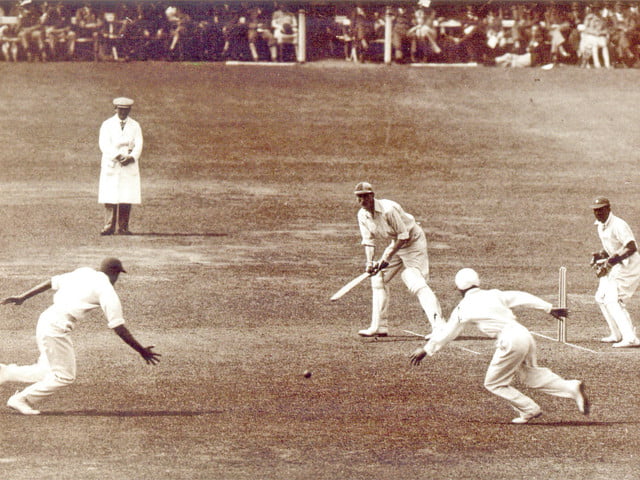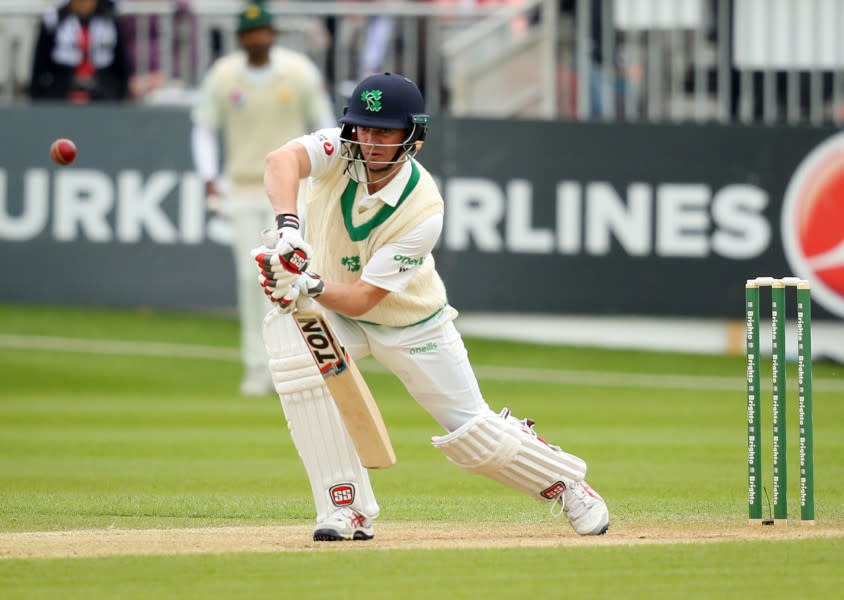Ireland’s men made a remarkably promising start to their Test careers (the women are ahead of them) despite losing to Pakistan by five wickets at Malahide, near Dublin.
The first day was lost to rain. Irish skipper William Porterfield won the toss and chose to field, and the experienced new ball pair of Boyd Rankin and Tim Murtagh soon reduced Pakistan to thirteen for two. Pakistan’s middle order fought back consistently but both sides would have been reasonably pleased with a close of play score of 268-for-six.
By close of play on the next (third) day things looked very different. Ireland were sixty-four-for-none, but this was their second innings; they were following on after being dismissed for 130 in response to Pakistan’s 310-for-nine.
The fourth day produced Ireland’s first Test hero: the thirty-four-year-old Kevin O’Brien made a magnificent 118, putting on 114 for the seventh wicket with all-rounder Stuart Thompson. Ireland’s total of 339 set Pakistan a challenging final day target of 160. When they were fourteen-for-three in the fifth over anything seemed possible. Imam-ul-haq, nephew of the great Inzamam (and one of twelve Test debutants in the match – Rankin had played for England) saw his country home.
Ireland became the eleventh Test-playing-country. Only one debutant country has won its first Test, and that was Australia which won the first Test of all, against England in Melbourne in 1876-77, by forty-five runs.
It may not be realistic to compare this match with others in this curious little category. One side or the other was likely to win; in the first forty Test matches there were only five draws. As was the case with many early matches, the teams were not genuinely representative. England were a side of touring professionals; there were no amateurs, and hence no W G Grace, the leading cricketer of the age. The opposition was the Grand Combined Melbourne and Sydney XI. The match was memorable for producing the first Test century, by the Australian opener Charles Bannerman, who retired hurt on 165. On the first day he made 126 out of 166-for-six.
South Africa’s first match was against England in Port Elizabeth in 1888-89. It was all over in under three days, England winning by eight wickets. South Africa were bowled out for 84 and 129. Opener Bernard Tancred, the oldest of five celebrated cricketing brothers, top scored with 29 in each innings for the home side. The England team had a decidedly irregular look to it. Led by fast bowler C A Smith, later to attain fame and fortune in Hollywood as Sir C Aubrey Smith, it contained two players who were making their debuts in first-class cricket.
Test cricket remained a three-member club until 1928, when West Indies toured England and played three Tests, losing them all by an innings, including the first at Lord’s. Eighteen months later an England team toured New Zealand, playing four Tests. Three were drawn but England won the first one, at Christchurch, by eight wickets. No batsman reached fifty in the match. In their first innings New Zealand at one stage were 21 for seven, fast bowler Maurice Allom, himself a debutant, taking four wickets in five balls, including a hat trick. As at Malahide, an entire day was lost to the weather. Perhaps the most curious thing about this game was that at exactly the same time another England team was playing the first Test of a four-match series against the West Indies in Barbados. Neither England side was especially strong: Jack Hobbs, Herbert Sutcliffe, Walter Hammond and Harold Larwood were given the winter off; but they were strong enough.

India at Lords, 1932
India played their inaugural Test at Lord’s in 1932. England won by 158 runs. No Indian made a half-century, but pace bowler Mohammad Nissar made an impact with the ball, reducing England to nineteen for three at the start of the game before captain Douglas Jardine came to the rescue.
In 1952-53 India was playing host to new rivals Pakistan, in Delhi. India won by an innings and 70 runs though seventeen-year-old Hanif Mohammed caught the eye for the visitors with fifty-one in the first innings (in which Vinoo Mankad took eight for fifty-two). Two of the Pakistan team, captain A H Kardar and all-rounder Amir Elahi, had previously played for India. Pakistan instantly launched their reputation for unpredictability by winning the second Test, in Lucknow, by an innings and 43 runs, the great Fazal Mahmood taking twelve for 94.
In 1981-82, after a gruelling tour of India, Keith Fletcher’s England side went to Sri Lanka to play in the island state’s inaugural Test at the Saravanamuttu Stadium in Colombo. England won by seven wickets. The sides were on level pegging after the first innings, with eighteen-year-old Arjuna Ranatunga making a precocious half century but Sri Lanka collapsed in their second innings, losing seven wickets for eight runs in 68 balls (John Emburey six for 32).
In 1992-93 came the second most successful debut performance after Australia when Zimbabwe secured a draw in their first Test, against India in Harare. Their substantial first innings total of 456 was built around a monumental innings of 121 from captain David Houghton, off 414 balls. He is the oldest Test debutant (35) to make a century. The wicket was too dead for a positive result to be achievable. Off-spinner John Traicos had played his last Test match, for South Africa, in 1969-79.
Considering how badly things have gone since – until very recently – Bangladesh’s performance in its first Test, against India in Dhaka in 2001-02, was not bad, or at least it started well enough. They made 400 first-time-round, with 145 from Ammal Islam. India made 429 and then bowled Bangladesh out for 91, winning by nine wickets. It was Sourav Ganguly’s first Test as captain and India’s first overseas win since 1994-95.
Bangladesh’s performance was entirely typical of a first Test performance: full of talent but lacking the stamina and the nous to cope with the peculiar demands of the five-day game. Doubtless something similar will happen when Afghanistan play India in June (sadly, without Virat Kohli and others). Ireland’s performance reflected the fact that their team contained a number of highly experienced professionals, most of them over thirty (Ed Joyce is nearer forty). They have a fine coach in Graham Ford and a highly regarded youth structure. But whether there is the strength in depth to live up to the expectations raised by their great days at Malahide remains to be seen.
Share this Post
